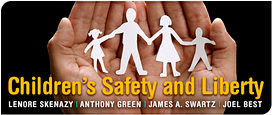How I wish Anthony Green could have read my book, Free-Range Kids, in which I write, “I love safety. I believe in helmets, car seats and seat belts.”
I even love his idea of a “designated texter,” and wish I’d come up with it myself! Frankly, anyone against implementing basic safety measures would have to be a little strange.
Anyone against trying to legislate out every last bit of risk in the world, well, that’s another story.
The idea shared by Green and fellow essayist (and injury lawyer) James A. Swartz is that every accidental child death could and should have been prevented. Which means that every accidental death is not an accident at all, but someone or something’s fault, and we must make sure it never happens again. Even if that means outlawing something as generally safe and normal as letting a kid wait in the car while her mom runs in for pizza, or letting a baby sleep in the crib all his older cousins used.
This is how a trial lawyer thinks: Any client who comes to him with a child hurt in even the most unusual and unpredictable manner has a legitimate claim against a practice, a person, or a manufacturer. This leads to situations like the following.
About a month ago, a child in Alberta, Canada, somehow nearly strangled to death on his hall pass lanyard. Immediately afterward, all 2,000 schools in the province declared lanyard hall passes a danger and banned them. But what if the student had tripped over a shoelace and fallen down the stairs? Should we outlaw lace-up shoes? Or stairs? Or what if he’d choked on an apple slice? From now on, only applesauce allowed at lunch?
Emotionally, to hear the story of the lanyard boy—it’s wrenching. No one could deny it. I certainly don’t. But I think we CAN deny that hall passes are inherently dangerous. They have been used for decades by I’d guess hundreds of millions of children, and here we have one child who almost died.
In an article about the incident, a local police spokesman was quoted as saying, “If [we] had any information ahead of time, this obviously would have been prevented.” But…that’s the point: We CAN’T have information about every accident ahead of time. If I know I’m going to get hit by a car on my way to work this morning, by golly, I’ll take the day off. But we can never know when something unpredictable is about to happen. Hence the word “unpredictable.”
The sad fact is that some of us, including some children, will end up hurt by things that are actually very safe. We used to call this God’s will, or bad luck, or fate.
Now we just call a lawyer. Or a lawmaker.
Or both.

